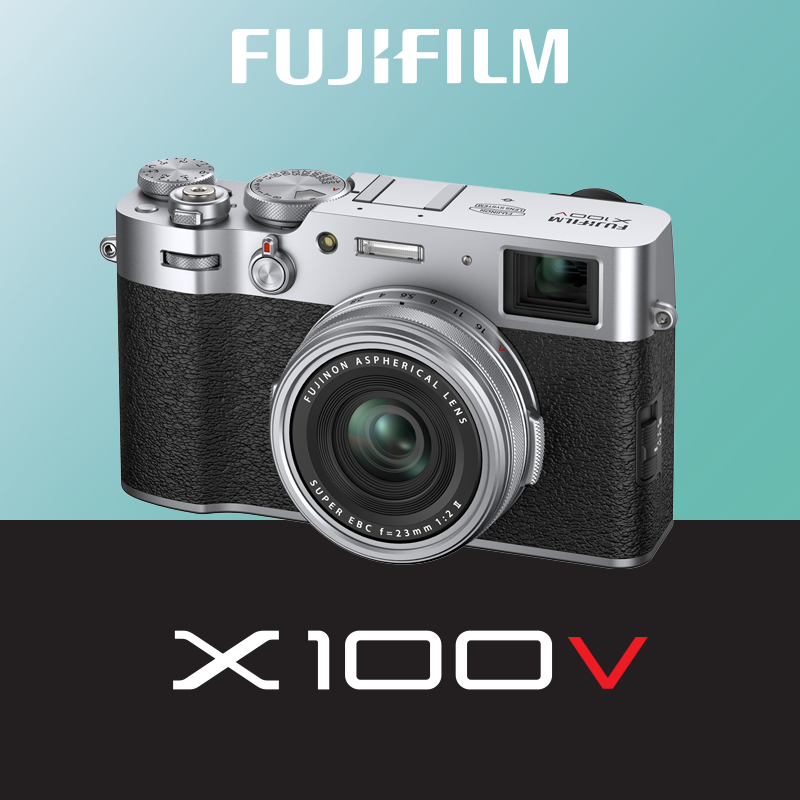We’ve had a ton of fun testing out the new Fuji X100V over the last couple of days, this is Fuji’s new premiere compact street camera. It’s packed with Fuji’s latest high-end technology, but the body is simplified with really intuitive analog controls that make this camera feel much more like a film camera than anything else.
A Simplified Design
The first thing we noticed is some slight body changes, one being that the X100V shows a simplified back. They’ve removed the circular selector and altered some of the button locations. The circular selector was used for a lot for quick menu items, those functions have now been moved to the new touch screen menu and can be customized to fit your needs. Swiping up down or left or right on the screen will bring up settings and modes such as film simulation, white balance, histograms, etc. This touch screen can also be turned off.
 The Back of the Fujifilm X100F vs. Fujifilm X100V
The Back of the Fujifilm X100F vs. Fujifilm X100V
In addition to the touch screen, the V also includes the much-anticipated tilt screen, making shooting certain angles much easier. It does not fully articulate, you’re limited to just a tilt, but it goes to a 90-degree angle in the tilt-up position, but is slightly limited in the down tilt location.
The touch screen isn’t the only thing you can customize, you can also customize the control ring on the lens, with numerous settings such as white balance and film simulation.
The finish on the body is also slightly different when compared to the X100F, it seems to have slightly less texture giving it a more shiny look. It also feels slightly more blocky and has more pronounced and thicker buttons, so control-wise it feels a little smoother and a little more analog.
 The Front of the Fujifilm X100F vs. X100V
The Front of the Fujifilm X100F vs. X100V
One big improvement here is the ISO selector, it now stays popped up, for easier rotation, then when you have your selected ISO, simply pop it back down. The old one required you to keep pulling it up when you rotated it.
We also noticed that the native ISO now goes down to 160 instead of 200, it also has an extended ISO range that drops it down to 80 and the max ISO’s are identical.
The V kept the viewfinder selector, for quick switching between the EVF view and a classic viewfinder. It has improved the resolution in the viewfinder with a 3.69M-dot EVF.
Now we thought this was a bit of a bummer, the X100V does not come with a separate charger, you’ll need to charge the battery in the body with the USB C port, or purchase an additional charger. Although, charging within the camera can sometimes come in handy if you need to charge in the car or while on the go. The USB C also allows for quicker file transfers if you connect your body to the computer that way.
At first look, it seems like they’ve kept the exact same lens, which is a 23mm F2, however, the leaf shutter that’s built-in is obviously much quieter when compared to the X100 F.
The 23mm lens on this body is the equivalent to a 35mm on a full-frame, which in my opinion is the perfect focal length for travel and street photography. It’s wide enough that you can capture the whole scene, but not so wide that it distorts objects in the background and it keeps the edges straight. The built-in ND filter is a 4-stop filter instead of a 3-stop in the X100F.
In-camera Improvements
The V sports a 26 MP sensor, that can shoot up to 11 frames per second, so a major jump up from the F, which was limited to 8 frames per second. In order to take full advantage of this, however, you’ll need a fast SD card, like a UHS-II. The focus points have also jumped from 325 to 425 and It has the same shutter max (electronic and mechanical).
We also see a huge jump on the video side. The X100V can shoot 4K video up to 30 frames per second for slow-motion and up to 120 frames per second in standard HD 1920 X 1080 for super slow motion. It additionally has an F-log format for flat shooting if you want to color grade later. You have the option of 50 Mbps, 100 Mbps, or up to 200 Mbps, depending on what format you’re shooting.
I however really appreciated the ability to shoot film simulations in video mode, for a pre-color graded look. If you’re unfamiliar with Fuji’s film simulation, this is what sets these cameras apart from other bodies. You can choose from a variety of looks and grains to give your shots and videos a particular film look without having to color grade later in post.
The one thing the bothered me when it came to video is the lack of a dedicated record button. As someone who frequently jumps back in forth between photo and video, I found this frustrating. The camera is either in video mode or photo mode and needs to be switched in order for the shutter release to operate as either a record button in video mode or shutter button in photo mode.
Now, that being said, I understand that the market for this camera is really meant to be more for the methodical photographer, but with video specs like that, I can really see this being adopted by more videographers that need a small compact system for quick shooting.
Like its predecessor, it comes in black and silver. The silver will be available on February 27th and the black will be available March 31st. Both are priced at $1,399.95 and available for pre-order.

